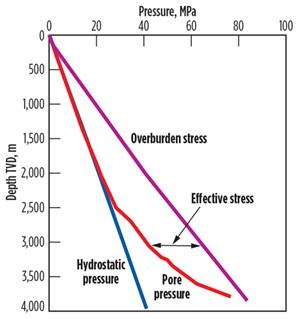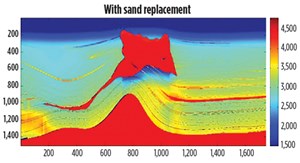I remember the first time I went offshore. We were visiting an active exploration well and landed (slammed down) on a helideck atop a very tall jackup, almost on the top rack. The vessel (or structure, since there was a substantial air-gap), positioned about 100 km off the northeastern coast of Brazil, was swaying with the currents coming from Trinidad. I wondered, if something bad happens here, where are the boats? On our way back, we force-landed in the jungle, when one of the hydraulics on our Super Puma gave out. Exploration doesn’t have to be dull. We found oil in that offshore location (the Foz do Amazonas). The big safety oops? We were more than 2 km off on our seismic navigation with big W. That was pre-GPS. Before we could shoot a new program, all exploration companies in Brazil were nationalized. Location, location, location.
We often look at drilling as proceeding, with some level of control or knowledge, into the unknown earth—assuming, that is, we are in the right place. More likely we mud up and wait. Watch the RPM, or in driller speak, revolutions per minute that really mean ft/hr and lb/gal. While such routine progress probably still occurs, blind drilling into forecasted horizons is not the same for most wells today. I don’t mean that we are pre-guessing depth any better. My all-time best guess took place in Patagonia, when I told the drillers the TD to within 4 ft (unfortunately, there were no hydrocarbons to interfere with my velocity determinations.) I also remember, April 10, 2010, a cased and cemented hole. One cannot overstate that the very exploration technologies we use every day, also have important roles to play in later production and [re]completion safety. A study of the subsurface should be as routine as any other KPI—way before an eruption comes blasting up a wellbore at you or your friends.

I also want to share early results from the SEAM/SEG/RPSEA/NETL-DOE project, 12121-6002-02.
SEAM has worked long and hard to make the model as physically realistic as possible. They found that to properly look at the use of seismic and petrophysics to predict pore pressure, they would need to have a model that contains a number of possible pore pressure scenarios. The resulting parameter would, necessarily, be an estimate of the differences between hydrostatic pressure and overburden pressures or mean stress, now called net or effective stress due to, as an interpretation, pore pressure, Fig. 1.
There are many pressure-generating mechanisms that are being considered for inclusion in the model; for example, 1) compaction disequilibrium, 2) lateral transfer (centroid effect), 3) clay diagenesis, 4) petroleum generation, 5) gas cracking and 6) salt tectonics. Other pressure generation mechanisms were discussed. The model can use equations of state to relate various rock parameters. Efforts will include attempts to include clay diagenesis. None of these properties are directly seen on seismic, but calculable from seismic attribute interpretations. The model will be “optimized” to calibrate against present-day acquisition geometry common to marine seismic libraries circa 2002, more or less, and forward.
A first effort contribution, from Anadarko, was presented at the RPSEA UDW Annual Conference in September, Fig. 2. This illustration shows a seismic velocity panel from the simulated offshore data—created from the RPSEA, SEAM 1 project, 0712102001—incorporating the first of the geologic conditions imagined by the working committee of experts. I think one would want to know what that red means before testing it with a large piece of hollow rotating steel with black diamonds.
“LAST CHANCE TO BOOK EXHIBIT SPACE FOR SEG'S ANNUAL MEETING IN NEW ORLEANS! BOOK YOUR EXHIBIT SPACE OR SPONSORSHIP TODAY!” SEG email blast, 9/22/15.
Considering that this convention was less than a month away at the time I saw this note, this message should be all the evidence needed to know that things could be better. Attend SEG, network and work the deals. Perhaps you could get an extended demo license for the workstation software you wanted to show the team. At the recent RPSEA Annual UDW Conference, cosponsored with the SPE Gulf Coast Section (GCS), Ivor Ellul, GCS chairman, said, in his keynote address, that by his estimates, we should see a recovery in the oil price in 2017. I tend to agree. Time enough to learn your new software. ![]()

- Quantum computing and subsurface prediction (January 2024)
- Machine learning-assisted induced seismicity characterization of the Ellenburger formation, Midland basin (August 2023)
- What's new in exploration (March 2023)
- Seismic and its contribution to the energy transition (January 2023)
- What's New in Exploration: Rocks can save or kill the planet (July 2022)
- Processing of a large offshore 3DVSP DAS survey in a producing well (June 2022)
- Applying ultra-deep LWD resistivity technology successfully in a SAGD operation (May 2019)
- Adoption of wireless intelligent completions advances (May 2019)
- Majors double down as takeaway crunch eases (April 2019)
- What’s new in well logging and formation evaluation (April 2019)
- Qualification of a 20,000-psi subsea BOP: A collaborative approach (February 2019)
- ConocoPhillips’ Greg Leveille sees rapid trajectory of technical advancement continuing (February 2019)



